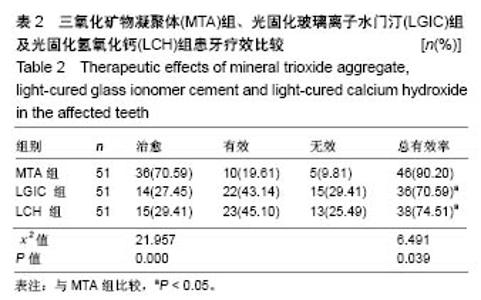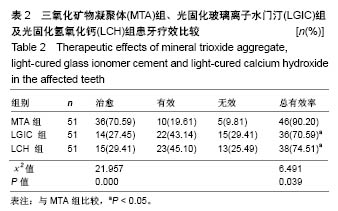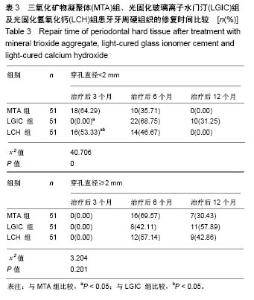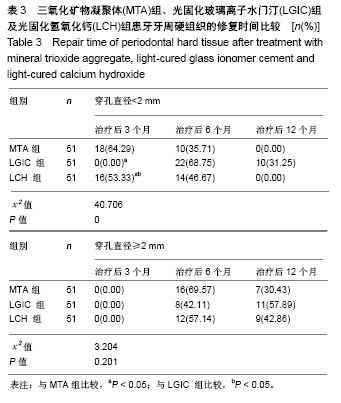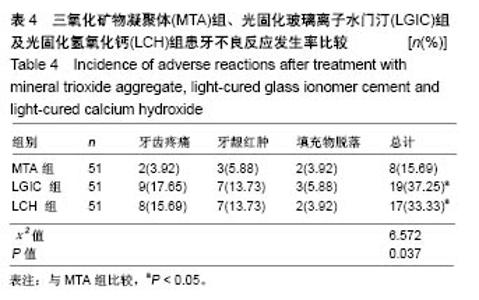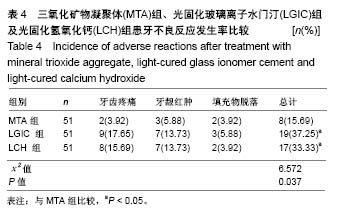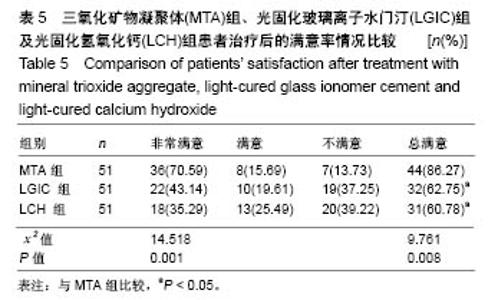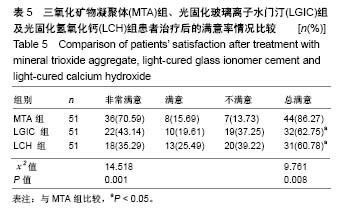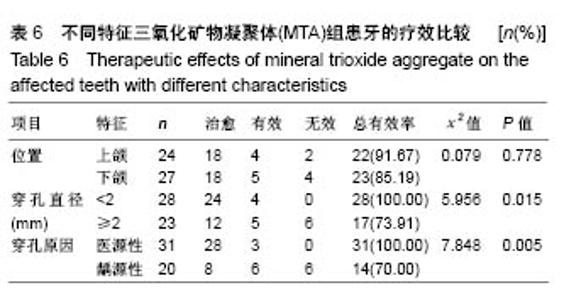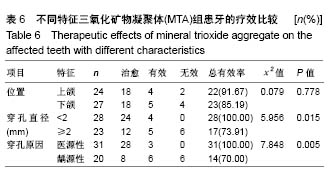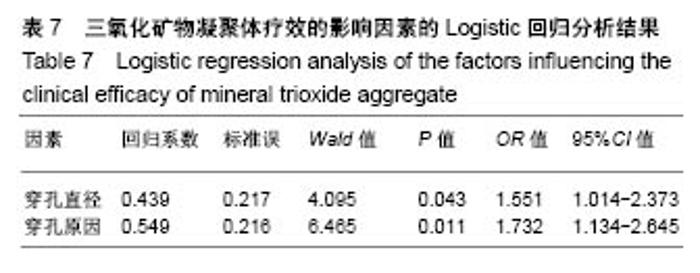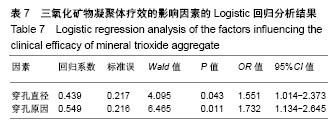| [1] 王密,尹世海,王奇,等.iRoot BP修复磨牙髓室底穿孔的研究[J].华西口腔医学杂志,2013,31(3):257-259, 266.[2] 白丽,张建丽.两种材料修补龋源性乳磨牙髓底穿孔的长期临床疗效比较[J].中国妇幼保健,2013,28(24):4064-4065.[3] Camilo do Carmo Monteiro J, Rodrigues Tonetto M, Coêlho Bandeca M, et al. Repair of iatrogenic furcal perforation with mineral trioxide aggregate: a seven-year follow-up. Iran Endod J. 2017;12(4):516-520.[4] Srinivasan R, Bhagabati N, Rajput A, et al. Non surgical repair of iatrogenic furcal perforation of radix entomolaris. Med J Armed Forces India. 2015;71(Suppl 2):S422-S424. [5] 邱延菊.磨牙髓室底穿孔保存治疗的研究进展[J].广东牙病防治, 2011,19(2):110-112.[6] Kakani AK, Veeramachaneni C, Majeti C, et al. A Review on Perforation Repair Materials. J Clin Diagn Res. 2015;9(9): ZE09-ZE13.[7] Gavic L, Gorseta K, Borzabadi-Farahani A, et al. Influence of Thermo-Light Curing with Dental Light-Curing Units on the Microhardness of Glass-Ionomer Cements. Int J Periodontics Restorative Dent. 2016;36(3):425-430. [8] 李淼,关朕,赵坤.矿物三氧化物凝聚体与玻璃离子修补髓室底穿孔的系统评价[J].中国现代医学杂志,2015,25(11):67-71.[9] Lara Vde P, Cardoso FP, Brito LC, et al. Experimental Furcal Perforation Treated with MTA: Analysis of the Cytokine Expression. Braz Dent J. 2015;26(4):337-341.[10] Katge FA, Shivasharan PR, Patil D. Sealing ability of mineral trioxide aggregate Plus™ and Biodentine™ for repair of furcalperforation in primary molars: an in vitro study. Contemp Clin Dent. 2016;7(4):487-492.[11] Haghgoo R, Arfa S, Asgary S. Microleakage of CEM Cement and ProRoot MTA as Furcal Perforation Repair Materials in Primary Teeth. Iran Endod J. 2013;8(4):187-190.[12] 蒋艺.玻璃离子和MTA治疗医源性髓室底穿孔疗效分析[J].中国保健营养(上旬刊),2013,9(上):4952. [13] 陈立锐.儿童龋齿与家长口腔保健意识的相关性分析[J].职业与健康, 2014,30(23):封2-封3.[14] Marques NC, Lourenço Neto N, Oliveira TM. Immediate and mediate furcal perforation treatment in primary molars: 24-month follow-up. Eur Arch Paediatr Dent. 2016;17(6):489-494. [15] Lara Vde P, Cardoso FP, Brito LC, et al. Experimental furcal perforation treated with MTA: analysis of the cytokine expression. Braz Dent J. 2015;26(4):337-441.[16] 谢惠兰,许君武,曹白雨,等.无机三氧化物聚合体与树脂嵌体修复大面积磨牙髓室底穿孔封闭性能比较研究[J].中国实用口腔科杂志, 2015,8(1):28-31.[17] Balachandran J, Gurucharan. Comparison of sealing ability of bioactive bone cement, mineral trioxide aggregate and Super EBA as furcation repair materials: a dye extraction study. J Conserv Dent. 2013;16(3):247-251. [18] 蒋澍,雷志敏.碳酸钙骨水泥联合bFGF充填修复髓室底穿孔的远期疗效分析[J].国际生物医学工程杂志,2017,40(3):169-172.[19] Haghgoo R, Niyakan M, Nazari Moghaddam K, et al. An In vitro Comparison of Furcal Perforation Repaired with Pro-root MTA and New Endodontic Cement in Primary Molar Teeth-A Microleakage Study. J Dent (Shiraz). 2014;15(1):28-32.[20] 何治一,张蓉,张平虎,等.2种复合树脂磨牙充填修复的临床评价[J].牙体牙髓牙周病学杂志,2016,26(4):240-244,253.[21] 骆小平.牙齿磨损的病因、分类及修复重建治疗进展[J].中华口腔医学杂志,2016,51(10):577-582.[22] Singh P, Paul J, Al-Khuraif AA, et al. Sealing ability of mineral trioxide aggregate, calcium phosphate cement, and glass ionomer cement in the repair of furcation perforations. Acta Medica (Hradec Kralove). 2013;56(3):97-103.[23] 刘冰,王海涛,韩建民,等.两种玻璃离子水门汀与不同基底物的黏接强度比较[J].山东医药,2017,57(18):28-30.[24] Mente J, Leo M, Panagidis D, et al. Treatment outcome of mineral trioxide aggregate: repair of root perforations-long-term results. J Endod. 2014;40(6):790-796. [25] 徐莹,郭剑苓,牛玉梅,等.氢氧化钙表面黏接处理对其压缩强度的影响[J].实用口腔医学杂志,2017,33(6):754-757.[26] Nagas E, Kucukkaya S, Eymirli A, et al. Effect of Laser-Activated Irrigation on the Push-Out Bond Strength of ProRoot Mineral Trioxide Aggregate and Biodentine in Furcal Perforations. Photomed Laser Surg. 2017;35(4):231-235.[27] Rahimi S, Ghasemi N, Shahi S, et al. Effect of blood contamination on the retention characteristics of two endodontic biomaterials insimulated furcation perforations. J Endod. 2013; 39(5):697-700. [28] 李飞来,阙国鹰.三氧化矿物凝聚体对牙乳头细胞增殖和分化影响的实验研究[J].中华口腔医学杂志,2013,48(6):343-347.[29] 王敏永,刘鹤,李盛林,等.三氧化矿物凝聚体对乳、恒牙牙髓细胞增殖和分化影响的比较[J].华西口腔医学杂志,2015,33(1):75-79.[30] Daltoé MO, Paula-Silva FW, Faccioli LH, et al. Expression of Mineralization Markers during Pulp Response to Biodentine and Mineral Trioxide Aggregate. J Endod. 2016;42(4):596-603.[31] 李歆,王津惠.三种髓室底穿孔修补材料的临床对比研究[J].临床口腔医学杂志,2016,32(8):488-489,490.[32] 刘伟.MAT修补根管侧穿髓底穿孔的作用研究[J].河北医学,2014, 20(8):1342-1344.[33] 蒋艺.观察玻璃离子(GIC)和三氧化矿物骨科(MTA)修复术后牙周组织炎症反应和硬组织形成影响[J].中国美容医学, 2013,22(17): 1795-1797.[34] Silva LAB, Pieroni KAMG, Nelson-Filho P, et al. Furcation perforation: periradicular tissue response to biodentine as a repair material byhistopathologic and indirect immunofluorescence analyses. J Endod. 2017;43(7):1137-1142. [35] 穆云静,焦艳萍,屈铁军,等.根管封闭剂MTA、AH-Plus对大鼠皮下组织相容性的研究[J].牙体牙髓牙周病学杂志,2017,27(8):449-453.[36] 梁宇红,王嘉德,于世凤,等.氢氧化钙调节骨代谢的体外研究[J].中华口腔医学杂志,2000,35(2):112-114.[37] 张莺,袁谷.VITAPEX糊剂与F2000复合体联合修复磨牙髓室底穿孔疗效观察[J].海南医学,2012,23(9):42-44.[38] 吴永杰.陈旧性髓室底穿孔治疗的短期临床疗效观察[J].中国医药科学,2014,4(3):185-187. |




